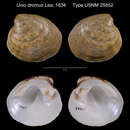en
names in breadcrumbs


Dromus dromas és una espècie de mol·lusc bivalve de la família Unionidae.
Viu a l'aigua dolça.[3]
Es troba als Estats Units: Kentucky, Tennessee i Virgínia.[3][4]
Dromus dromas, the dromedary pearlymussel or dromedary naiad, is a rare species of freshwater mussel in the family Unionidae. This aquatic bivalve mollusk is native to the Cumberland and Tennessee River systems in the United States, where it has experienced a large population decline. It is a federally listed endangered species of the United States.[4][5]: 24064
This mussel is yellow-green in color with interrupted green rays on the shell. The nacre is white, pink, or reddish. The species got its name from the distinctive hump on the shell of larger individuals.[6] A "headwaters form," D. dromas form caperatus (Lea, 1845) has additionally been described.[6]: 9–10
This species lives in clear, clean, fast-flowing water. It cannot tolerate water of poor quality, for example, water with silt.[7]
Like other freshwater mussels, this species reproduces by releasing larvae called glochidia into the water. The glochidia are eaten by fish and lodge in the fish's gills, where they develop into juvenile mussels. Fish hosts for this mussel species include black sculpin (Cottus baileyi), greenside darter (Etheostoma blennioides), fantail darter (Etheostoma flabellare), snubnose darter (Etheostoma simoterum), tangerine darter (Percina aurantiaca), blotchside logperch (Percina burtoni), logperch (Percina caprodes), channel darter (Percina copelandi), gilt darter (Percina evides), and Roanoke darter (Percina roanoka).
This species was historically one of the most common mussels in the Tennessee and Cumberland rivers.[6]: 2–3 In 1978, however, only three living specimens could be found during a Tennessee River survey, all from the Chickamauga Reservoir.[6]: 3 Similarly, two live individuals were found in a Cumberland River survey in 1976, with another individual located in a commercial mussel fisherman's boat, while dead specimens were found at a rock-quarry clammer's camp.[6]: 3, 5 Today, the species has been reduced to no more than four populations (two of which are experimental and non-essential).[4][8] It has been extirpated from the wild in the state of Alabama, but it has been reintroduced there (experimental population).[4] The only remaining reproducing populations occur in the Clinch and Powell Rivers.[7] Reproducing populations remain in under 10% of the mussel's historical range, and the populations are disjunct.[9]
Factors contributing to its decline include the impoundment of waterways, increased silt, and pollution from sewage, coal mining, and oil and gas drilling.[7]
Between 2016 and 2019, mass die-offs of D. dromas, possibly attributable to viral diseases, occurred in the Clinch River population.[8]: 11
Dromus dromas, the dromedary pearlymussel or dromedary naiad, is a rare species of freshwater mussel in the family Unionidae. This aquatic bivalve mollusk is native to the Cumberland and Tennessee River systems in the United States, where it has experienced a large population decline. It is a federally listed endangered species of the United States.: 24064
This mussel is yellow-green in color with interrupted green rays on the shell. The nacre is white, pink, or reddish. The species got its name from the distinctive hump on the shell of larger individuals. A "headwaters form," D. dromas form caperatus (Lea, 1845) has additionally been described.: 9–10
This species lives in clear, clean, fast-flowing water. It cannot tolerate water of poor quality, for example, water with silt.
Like other freshwater mussels, this species reproduces by releasing larvae called glochidia into the water. The glochidia are eaten by fish and lodge in the fish's gills, where they develop into juvenile mussels. Fish hosts for this mussel species include black sculpin (Cottus baileyi), greenside darter (Etheostoma blennioides), fantail darter (Etheostoma flabellare), snubnose darter (Etheostoma simoterum), tangerine darter (Percina aurantiaca), blotchside logperch (Percina burtoni), logperch (Percina caprodes), channel darter (Percina copelandi), gilt darter (Percina evides), and Roanoke darter (Percina roanoka).
This species was historically one of the most common mussels in the Tennessee and Cumberland rivers.: 2–3 In 1978, however, only three living specimens could be found during a Tennessee River survey, all from the Chickamauga Reservoir.: 3 Similarly, two live individuals were found in a Cumberland River survey in 1976, with another individual located in a commercial mussel fisherman's boat, while dead specimens were found at a rock-quarry clammer's camp.: 3, 5 Today, the species has been reduced to no more than four populations (two of which are experimental and non-essential). It has been extirpated from the wild in the state of Alabama, but it has been reintroduced there (experimental population). The only remaining reproducing populations occur in the Clinch and Powell Rivers. Reproducing populations remain in under 10% of the mussel's historical range, and the populations are disjunct.
Factors contributing to its decline include the impoundment of waterways, increased silt, and pollution from sewage, coal mining, and oil and gas drilling.
Between 2016 and 2019, mass die-offs of D. dromas, possibly attributable to viral diseases, occurred in the Clinch River population.: 11
Dromus dromas es una especie de molusco bivalvo de la familia Unionidae.
Es endémica de los Estados Unidos.
Dromus dromas é uma espécie de bivalve da família Unionidae.
É endémica dos Estados Unidos da América.
Dromus dromas é uma espécie de bivalve da família Unionidae.
É endémica dos Estados Unidos da América.
走蚌(學名:Dromus dromas),又名單峰駱駝真珠蚌[3],是一個罕見的淡菜物种,屬於蚌科的淡水(英语:Aquatic animal)雙殼綱軟體動物、美國特有的淡水蚌物種。由於其數量大幅下降,本物種獲聯邦政府認可為瀕危物種。
這種貽貝呈黃綠色,殼上有綠色的幅射線。珠母層是白色、粉紅色或微紅色。本物種的名字來源於較大個體外殼上獨特的「駝峰」[4]。
本物種分佈於美國田納西州及維吉尼亞州的田納西河流域及坎伯蘭河流域[3]。其棲息地為清澈、潔淨及快速流動的水流。牠們無法忍受差水質,比如:混有淤泥的水[5]。
歷史上,本物種為田納西河最常見的蚌科物種,但現時在河中只能找到老年的個體:現時只剩下四隻。本物種基本上在亚拉巴马州野外已經局部地區滅絕,但被人工再度引進。餘下的物種繼續在克林奇河及鮑威爾河(英语:Powell River (Tennessee River))繁殖[5],但無論怎樣,其數量始終無法超越歷史數量的十分之一,而且還是有間斷的統計[6]。
具體來說,影響到走蚌數量下降的原因計有[5]:
|year= / |date= mismatch中的日期值 (帮助); 外部链接存在于|work= (帮助)